Large horse breeds symbolize power and wealth. These breeds have been used to pull carriages or plows, for riding, for breeding, or for sport and leisure.
Our detailed guide lists some of the biggest horse breeds. We also explore their history and characteristics that make them unique.
Table of Contents
13 Biggest Horse Breeds
Here are thirteen of the world’s largest horse breeds:
1. American Cream Draft
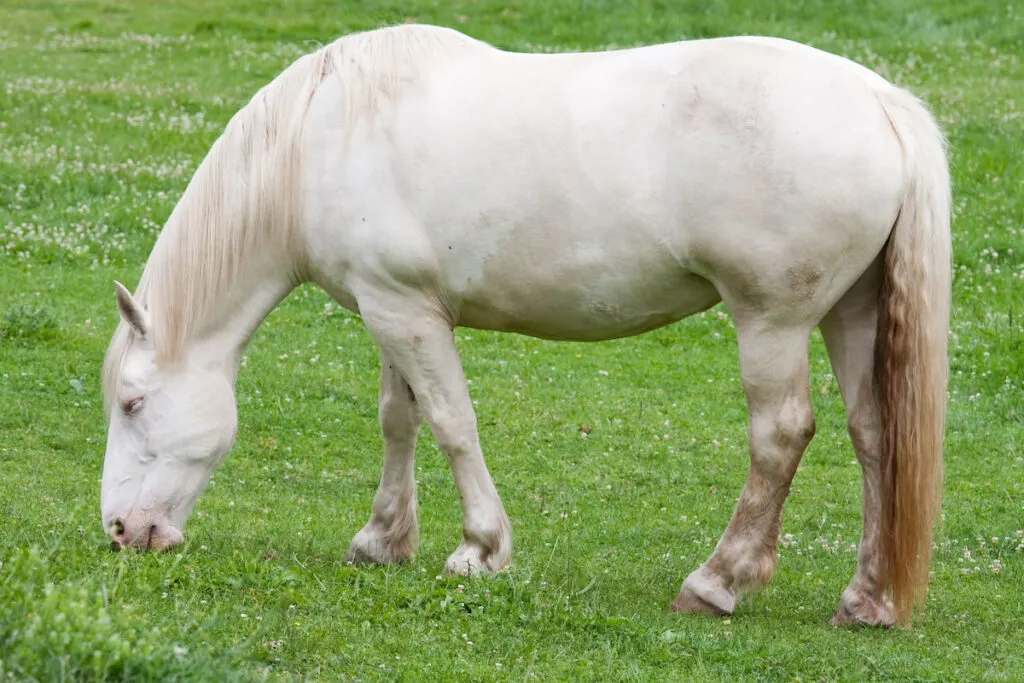
- Place of Origin: United States
- Weight: 1,600-1,800 pounds
- Height: 15-16.3 hands
- Color: Cream coat and white mane or tail
- Temperament: Friendly and calm
- Lifespan: 20-35 years
The American Cream draft horse is the only draft horse breed that has its origins in the U.S.
According to history, the breed came from one draft mare from Iowa in the 1900s that gave birth to cream-colored offspring. Over the years, the breed’s numbers have declined, and it is considered an endangered breed.
American Cream draft horses have a unique cream color that can either be pale or a darker shade. They also have pink skin under their cream coat, and their tail and mane are white.
Their eyes can be brown or amber.
These horses are docile and friendly, which makes them suitable for novice horse owners. They are willing to learn and are gentle.
American Cream draft horses also make excellent farm workers. Their muscular and sturdy bodies can easily pull carriages and other farm tools.
The breed also makes fantastic riding and show horses as they’re easy to handle.
Although the American Cream draft is one of the large horse breeds, it’s not as tall as others. Its average height is 15-16.3 hands.
However, they are heavy and muscular, weighing between 1,600-2,000 pounds.
Being a large breed means this horse breed requires a spacious enclosure that allows them to move comfortably. They also need enough outdoor time daily.
American Cream draft horses adapt to the environment, thanks to their origin.
2. Australian Draught
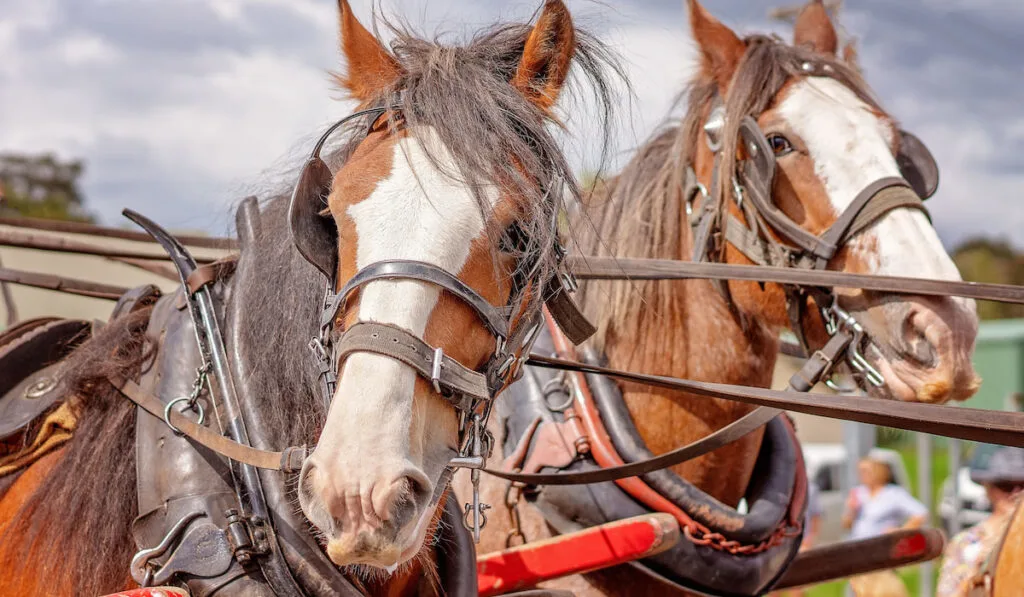
- Place of Origin: Australia
- Weight: 1,300-1,980 pounds
- Height: 16-17.3 hands
- Color: Brown, black, white, roan, gray
- Temperament: Peaceful and friendly
- Lifespan: 30-40 years
The Australian Draught horse is originally from Australia and was developed in the 1800s as a means of transport.
There are different types of Australian Draught horses, but their height is about 16-17.3 hands.
The Australian Draught horse combines four purebred draft (draught) horses, the Shire, Percheron, Clydesdale, and Suffolk Punch.
Crossing four pure draft breeds led to a breed that could survive in extreme conditions, was strong, and had an even temperament. That’s why Australian draft horses were for farm and labor purposes.
However, the breed is mainly used for various competitions today.
Australian Draught horses can be brown, black, white, roan, or gray.
They are famous for their friendly temperaments and calm nature, which makes them easy to train.
The breed’s dietary requirements depend on age, size, and work level. They like to feed on grain and hay.
Australian Draught horses used for competitions may also need additional supplements and proper nutrition as they tend to lose weight quickly.
Modern Australian Draught horses are now used as riding horses, hitch horses, and show horses. Some cities use them to pull trolleys.
3. Ardennes
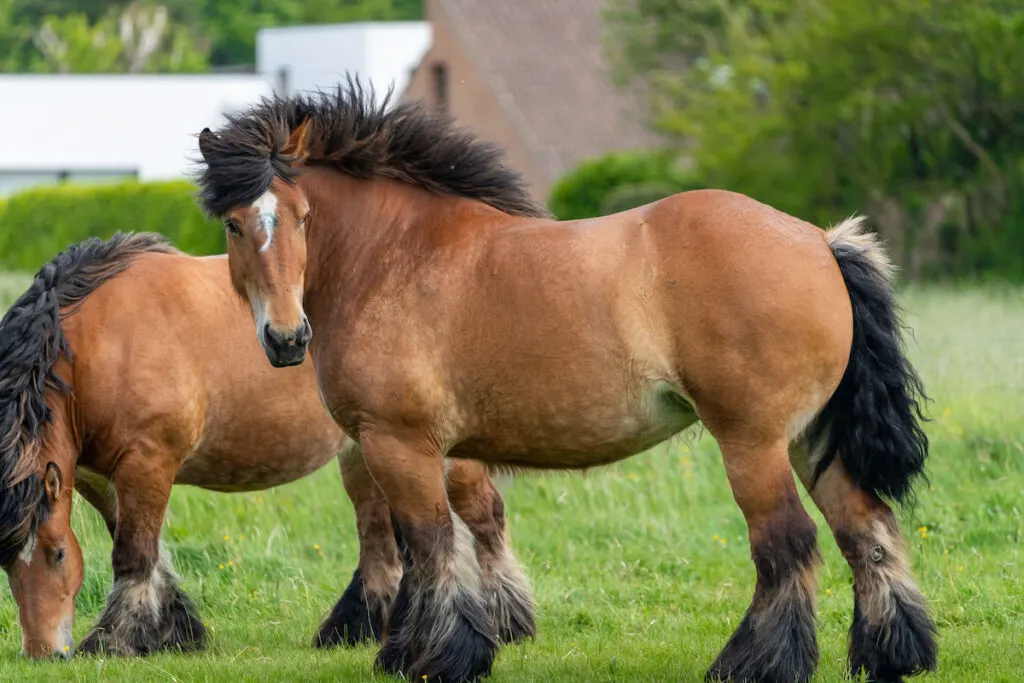
- Place of Origin: Belgium, France, Luxemburg
- Weight: 1,500-2,200 pounds
- Height: 15-16 hands
- Color: Chestnut, Bay, Roan, Palomino
- Temperament: Patient, Intelligent, Affectionate
- Lifespan: 30 years
The Ardennes horse breed is from Europe. It’s originally from a region in Belgium called Ardennes.
These horses were mainly used for draft work. However, the breed has been crossbred with other breeds over the years to make them stronger and bigger.
Ardennes horses stand at 16 hands high and weigh close to 2,200 pounds on average. Their legs are muscular, which gives them superb pulling power.
If you’re looking for horses that are patient, intelligent, and easy to work with, you’ll find all these traits in the Ardennes horse.
They are also calm and docile, which makes them perfect for beginner horse owners.
The breed is hardy and can adapt to any weather.
Ardennes horses feed on hay and grass but may need supplements if you plan to use them for work.
Although Ardennes horses were primarily used as draft horses, they were also used for competitive driving, pleasure riding, and pulling farm equipment.
Ardennes horses also make excellent therapy horses due to their tolerant personality and kind temperament.
Ardennes require thorough grooming due to the feathering around their hooves. Failure to clean the feathering can lead to the horse developing scratches.
4. Belgian Draft
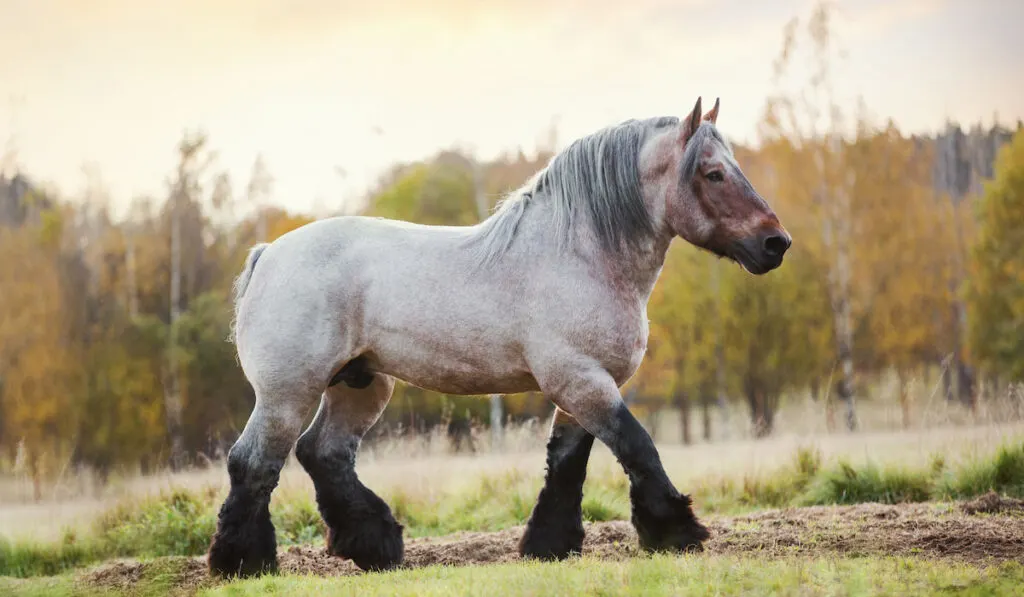
- Place of Origin: Belgium
- Weight: 1,800-2,200 pounds
- Height: 16.2-17 hands
- Color: Roan, Chestnut, Red, Sorrel
- Temperament: Friendly and docile
- Lifespan: 18 years
The Belgian draft horse dates back to the 17th century and is considered one of the strongest, biggest horse breeds.
The breed originated in Belgium and was used to transport medieval knights into battle due to its masculinity and strength.
Belgian draft horses can have a chestnut, sorrel, or red coat with a light blonde tail and mane. Some horses have white marks on their face and legs.
Belgian horses have straight noses, kind eyes, and thick necks. They have small heads compared to their massive, muscular body. Their back is wide and short.
These horses weigh between 1,800-2,400 pounds, with the heaviest horse recorded at 3,200 pounds in 1946.
Belgian draft horses can also be between 16-18 hands, making them one of the tallest horse breeds.
Their height also contributes to their power. Interestingly, Belgian horses in the U.S. are taller than those in European countries.
Despite being huge, Belgian draft horses have a kind and gentle temperament. They are hardworking and calm.
After interacting with them, you’ll notice their unique personality. All these traits combined make them ideal for beginners and families with kids.
Another thing about the Belgian horse is that the breed eats a lot but has a slower metabolism. Hay and grass are its primary diet.
Modern Belgian horses are used to pull carriages in city streets and parks. They can also be used for logging and plowing.
Belgian drafts are also used as riding horses, and you’ll find many in vaulting competitions.
These horses require regular grooming like other horse breeds. Besides brushing their hair, extra attention should be paid to their hooves.
Their hooves should be trimmed and cleaned consistently to prevent infections and injuries.
5. Boulonnais
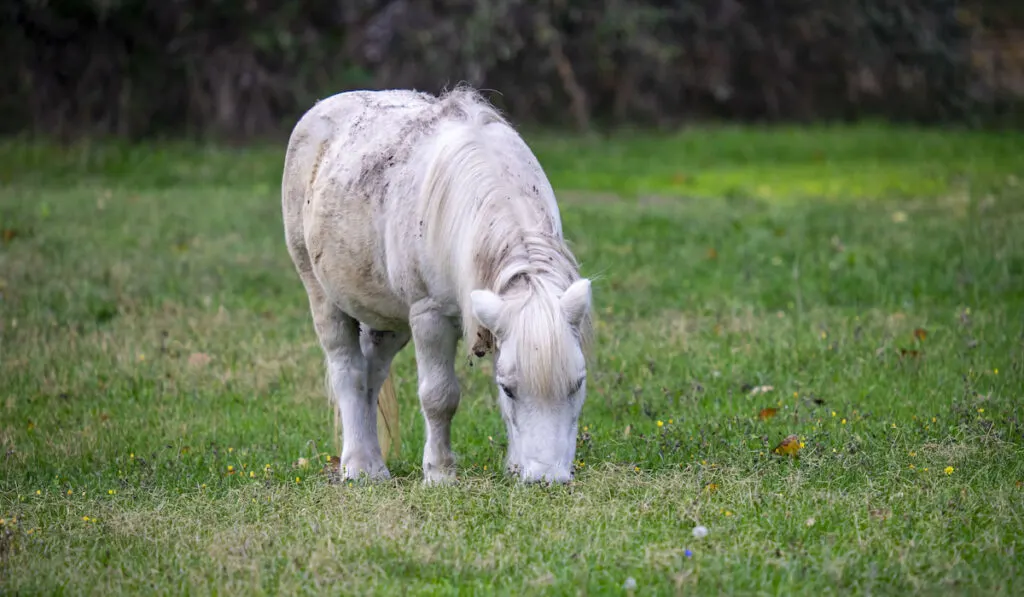
- Place of Origin: France
- Weight: 1,250-1,650 pounds
- Height: 14.3-16.3 hands
- Color: Chestnut, gray, black
- Temperament: Docile, energetic, gentle
- Lifespan: 20-30 years
The Boulonnais horse breed exhibits elegance and poise. They are known for their milky white coat and luxurious mane.
Originally from the Boulogne District of France, Boulonnais horses may have been imported by Julius Caesar before he invaded Britain.
Their physique is also distinct. A Boulonnais horse has a short head with a broad forehead, muscular neck, wide chest, straight back, strong legs, and thick mane.
Boulonnais horses get their majestic demeanor from their unique physique and mane.
Most horses have a creamy coat, but it’s also common to find some breeds with black and chestnut colors.
On average, an adult Boulonnais weighs about 1,400-1,650 pounds and stands 14.3-16.3 hands tall.
Boulonnais are sociable horses that are easygoing and friendly despite their size. Horse keepers also find them easily trainable and energetic during physical activities.
Boulonnais horses are now used for general riding and fieldwork. Some people also breed and raise them for meat.
6. The Burmese Pony
- Place of Origin: Burma
- Height: 12-13 hands
- Color: Brown, chestnut, gray, black, bay
- Temperament: Quiet, friendly, easygoing
- Lifespan: 15-18 years
The Burmese pony, or the Shan Pony, is commonly found in mountainous regions. These horses are native to Eastern Burma and share similarities with Spiti and Bhutia ponies.
Having been bred and raised in a mountain habitat, these horses are hardy and can survive in any environment.
Modern Burmese ponies are used for mountain trekking, packing, and riding.
These horses can be chestnut, black, bay, or gray.
Their physique is also unique: a straight profile head, a muscular neck, a long back, and a sloping croup. They also have upright shoulders and broad chests.
Burmese ponies are ideal for beginners due to their calm and quiet demeanor. They are also friendly and suitable for kids.
7. Clydesdale
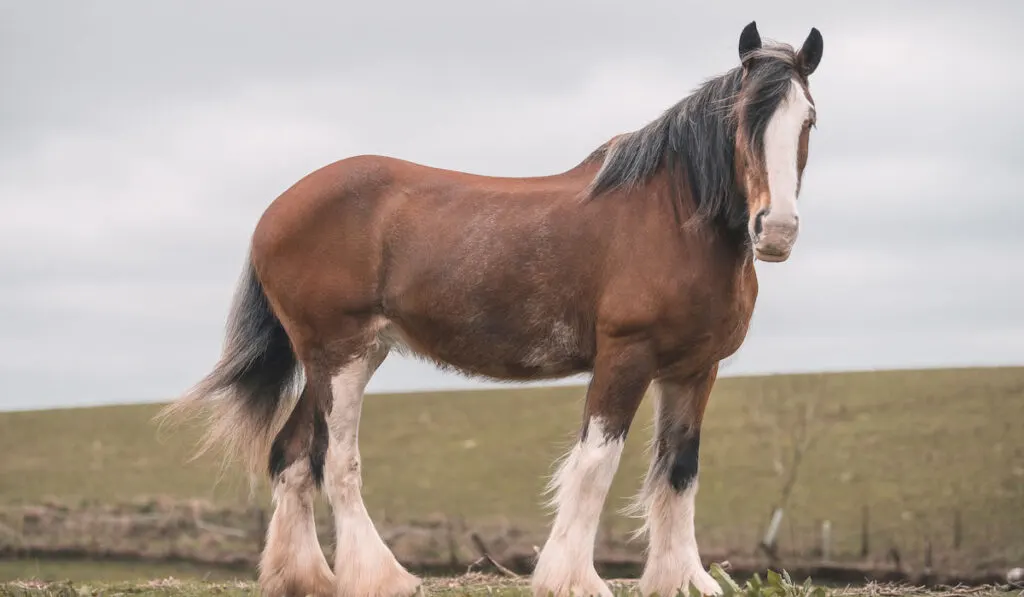
- Place of Origin: U.K., Scotland
- Weight: 1,500-2,200 pounds
- Height: 16.4-18 hands
- Color: Brown, gray, black, bay, roan with spots
- Temperament: Friendly, calm
- Lifespan: 20-30 years
Clydesdale horses are an easily recognizable big horse breed thanks to their majestic stature and high-stepping gait.
Originally from Scotland, the breed got its name from the River Clyde.
Scottish settlers introduced the breed to Canada and later to the U.S., where they were used to pull wagons, plow fields, and perform other heavy tasks due to their endurance and strength.
Most Clydesdales have a bay color, but it’s common to spot some that are gray, black, or chestnut. The coats can have some roan markings or be solid.
White facial markings are also found in some horses. Their legs are also white with lots of feathering.
One defining feature is their large hooves that look like frying pans.
Each Clydesdale hoof weighs about five pounds – quadruple what an average racing horse hoof weighs.
Clydesdales are also tall, standing between 16-18 hands on average. Stallions weigh more and are taller than mares.
Modern Clydesdales are used for driving and riding. They are also used as drum horses in parades thanks to their height.
In some cases, Clydesdales are also used as trail horses due to their strength and agility.
Being big horses, the Clydesdales eat and drink a lot. Their primary diet consists of grain and hay. Feeding needs change, depending on activity level and age.
Unlike other horse breeds, Clydesdales need extra grooming because of their size. Their legs need to be shampooed because of the feathering, and their hooves must be cleaned and inspected continuously.
Keeping Clydesdales can be expensive, as they require plenty of space due to their size. They also eat more food and need regular grooming.
8. Comtois
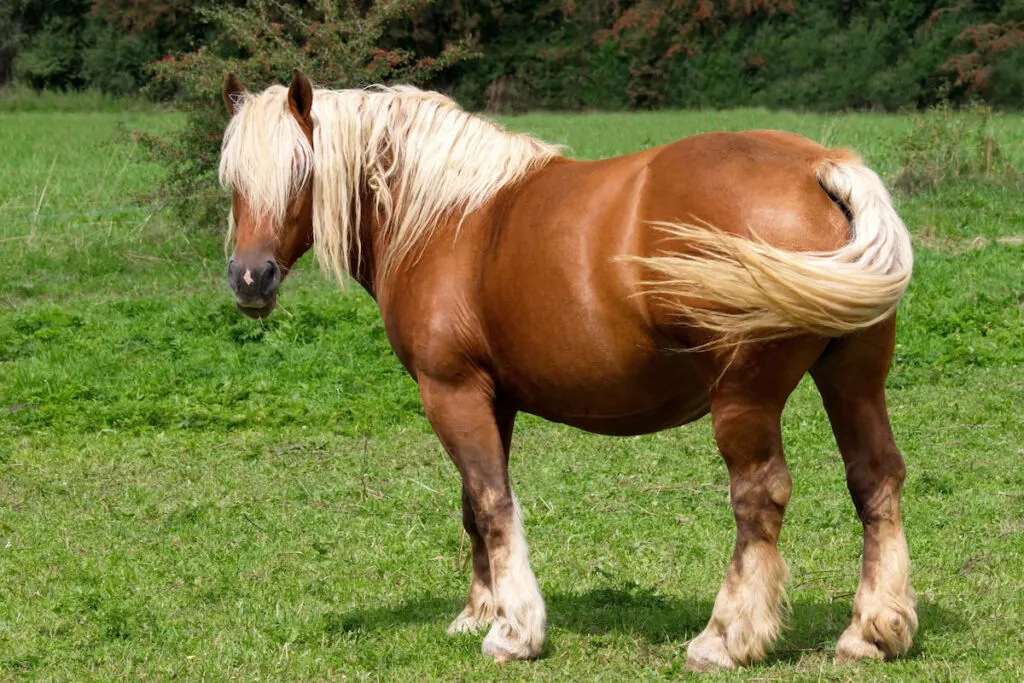
- Place of Origin: France
- Weight: 1,430-1,760 pounds
- Height: 14.3-16.1 hands
- Color: Black, chestnut, bay, silver
- Temperament: Energetic, friendly, quiet, willing to work
The Comtois horse breed originates from Switzerland and France. It’s popular, like the Belgian draft horse.
Napoleon may have used this breed as a war horse.
Crossing the breed with Percheron, Boulonnais, and Ardennes sires created the modern Comtois that is massive and agile.
Comtois horses can have either a rich copper chestnut or dark chocolate color, but there are also black and bay breeds.
Additionally, some horses have the silver dapple gene, which makes them attractive.
The breed also has a lengthy back and short legs with slight feathering. Their hindquarters are rounded and muscular, while their chest is deep.
Comtois horses weigh about 1,400-1,750 pounds, while their height is between 14.3-16.1.
Bred and raised as draft animals, Comtois horses are hardy and willing to work. Individuals willing to keep horses with little space will find the breed convenient as they are compact and take little space.
Modern Comtois horses are used as workhorses thanks to their strength and calmness. They are also used for drawing carriages, pleasure riding, and driving competitions.
9. Dutch Draft
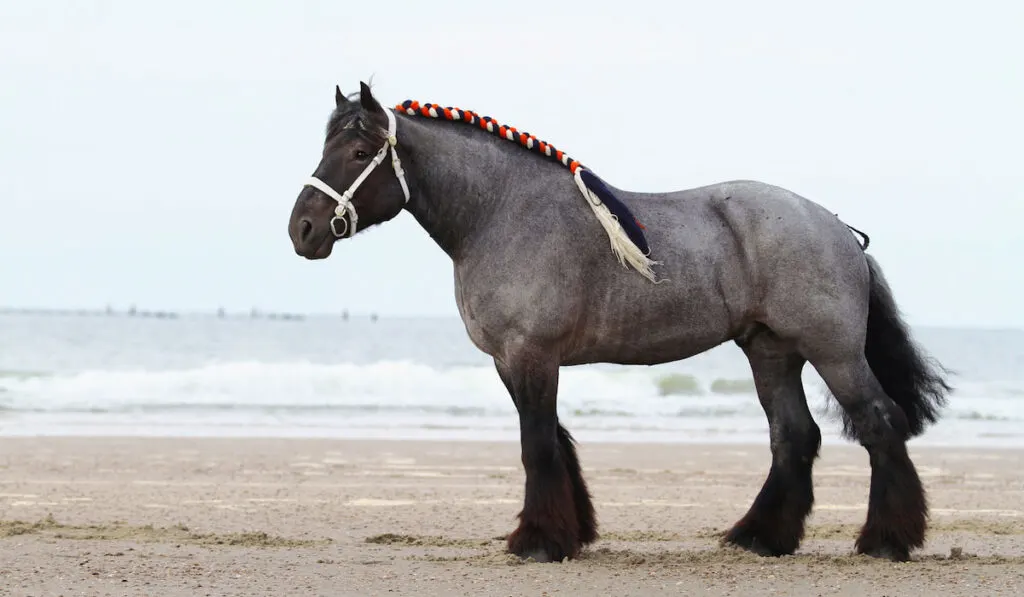
- Place of Origin: Netherlands
- Weight: 1,540-1,650 pounds
- Height: 15.2-16 hands
- Color: Chestnut, black, gray, bay
- Temperament: Friendly, calm, affectionate
- Lifespan: 25 years
The Dutch draft has a similar build to the Belgian draft. It was developed in 1914 in Holland as farm work and heavy draft breed. As a result of crossbreeding, the Dutch Draft became a strong muscular horse with solid legs, a straight profile head, and muscled hindquarters.
The primary colors of the Dutch draft are brown, black, chestnut, and roan variations. These colors are standard due to the Belgian draft horse influence.
Rare colors like black and gray are also found in Dutch draft horses.
The breed is short compared to other famous draft horses. It’s between 15-17 hands and weighs about 1,500-2,000 pounds.
Although they are not the tallest, Dutch draft horses are strong and have the stamina for work.
Another significant characteristic is the breed’s calm and gentle temperament.
The Dutch draft is slow and walks in steady, slow movements.
These horses can be stubborn if mistreated, but they are friendly and willing workers when shown affection.
Draft horses’ main diet consists of hay, but occasionally grain and other supplements can be included depending on their level of work.
Furthermore, they are easy to care for and require little maintenance.
Modern Dutch draft horses are used for riding, recreation, and dressage competitions.
10. Jutland Horse
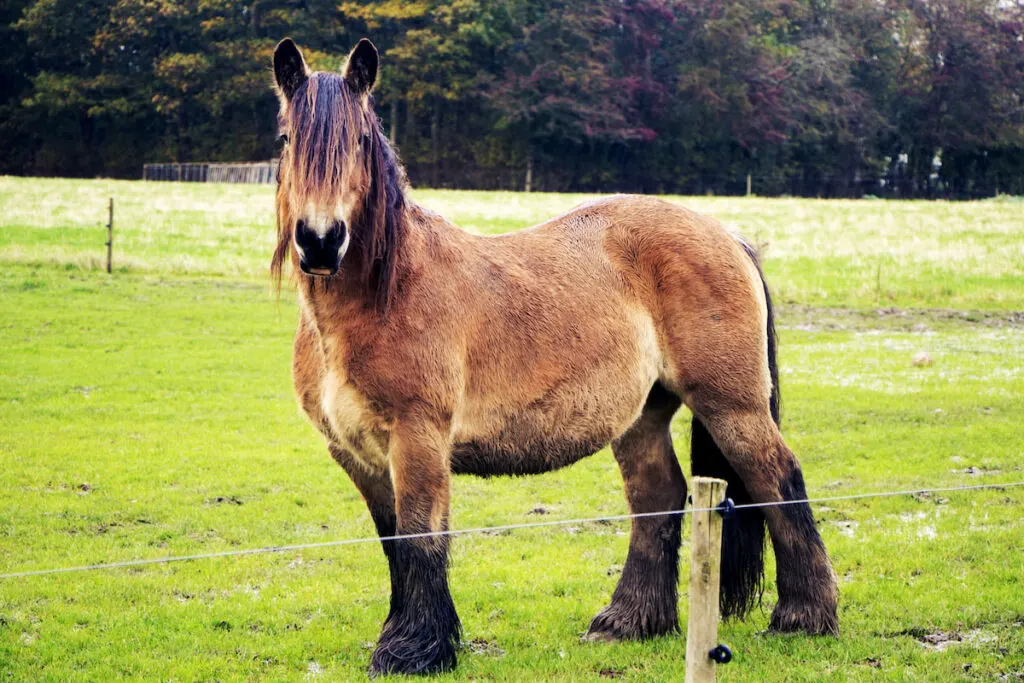
- Place of Origin: Denmark
- Weight: 1,500-1,800 pounds
- Height: 15-16 hands
- Color: Brown, black, chestnut, gray, roan
- Temperament: Energetic and friendly
- Lifespan: 25-30 years
The Jutland horse breed got its name from the Jutland Peninsula in Denmark. In ancient times, these horses were used as draft horses and for horse shows due to their muscular and compact nature.
The breed is believed to contain the bloodlines of the Suffolk horse and the Shire horse.
Physical characteristics of the Jutland horse include its powerfully muscled shoulders, strong hindquarters, and feathering on all legs.
A Jutland is typically chestnut in color, although it can also be gray, black, and roan with white markings.
Most Jutland horses weigh between 1,500-1,800 pounds and stand between 15- 16.1 hands tall.
Jutland horses have a gentle temperament despite their strength and size.
They are kind, calm, and willing to work. That makes them ideal for hauling farm equipment and doing other farm work.
Modern Jutland horses are used for performing farm work and lugging big items.
Caring for the Jutland horse takes effort, as it needs to be harnessed to limit its activity, which could lead to lameness, over-exertion, and other problems. They also need ample food regularly.
11. Percheron
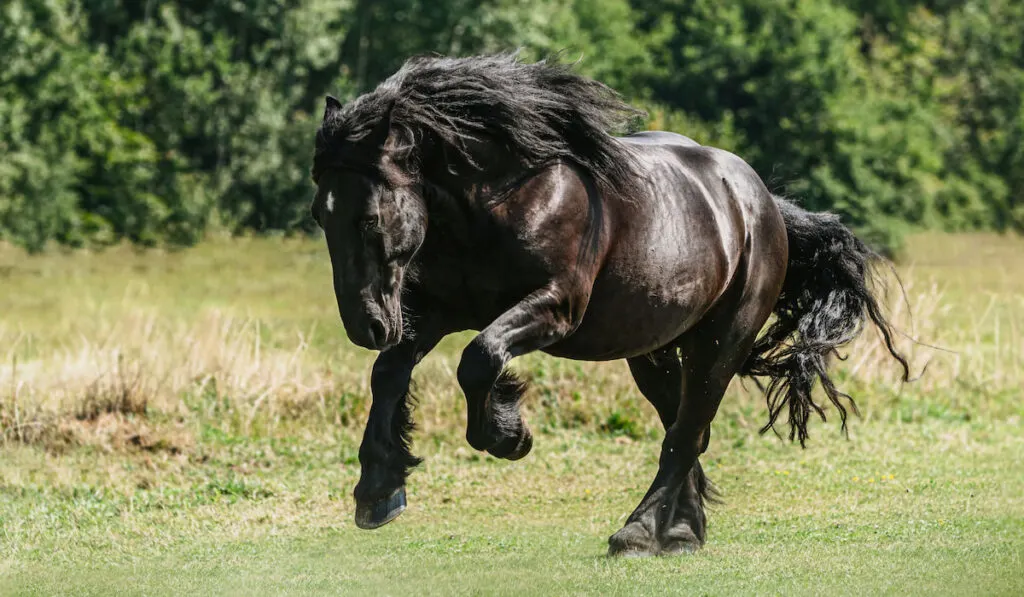
- Place of Origin: France
- Weight: 1,900-2,100 pounds
- Height: 16-17 hands
- Color: Chestnut, gray, black, bay, sorrel, roan
- Temperament: docile, calm, easy to train
- Lifespan: 30-40 years
Percherons, also known as gentle giants, were once war horses and later became powerful draft horses.
The breed was first developed in France’s Perche province. They were further developed in the 1800s to be used as cavalry horses.
Percherons were later introduced in the U.S. in the late 1800s before becoming a popular breed in the 1900s.
These horses can be black, chestnut, gray, sorrel, bay, or roan. However, Percherons bred in France are born black but turn gray when they reach maturity.
Percherons weigh about 1,800-2,600 pounds and stand 16-17 hands on average.
Percherons have muscular legs and thick, wavy manes and tails.
The breed is known for its eagerness to please, intelligence, and unmatched stamina.
These horses eat more than regular-sized horses and feed on grains and hay. Percherons that can’t forage in pasture may also need mineral and vitamin supplements.
Percherons are today used as working animals. They can also be used for driving and riding. On average, Percherons can live for 25-30 years, longer than most draft horses.
12. Shire Horse
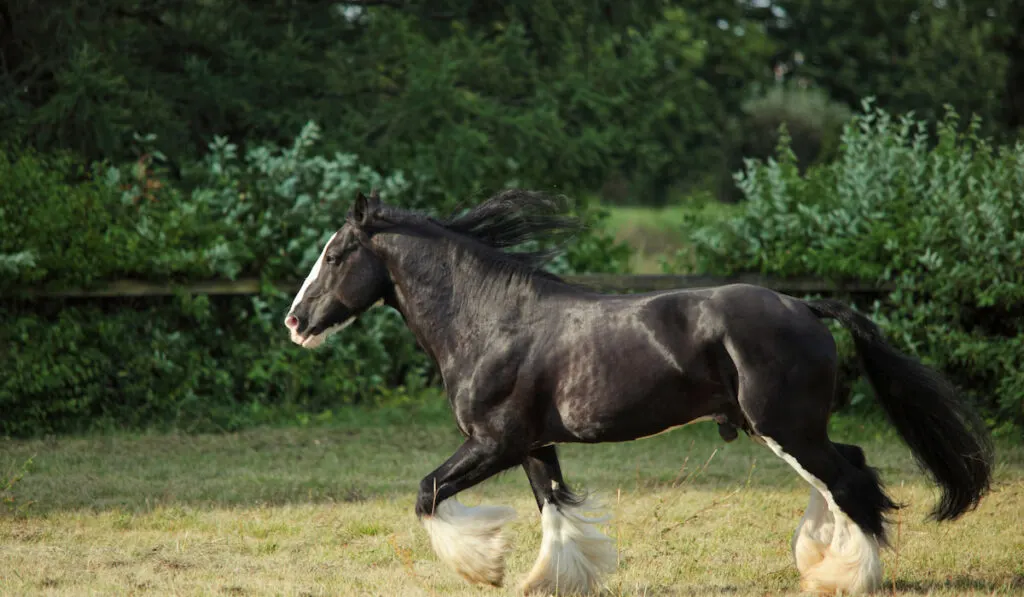
- Place of Origin: U.K.
- Weight: 1,800-2,400 pounds
- Height: 16-18 hands
- Color: Grey, brown, bay, black, chestnut, roan
- Temperament: Easy-going, docile, patient
- Lifespan: 20-45 years
The Shire horse breed is considered one of the world’s heaviest and tallest horse breeds.
In the 18th century, the Shire horse was developed. It’s believed that Shires were used as war horses to carry knights into battle. They were also used for farm work, cart-pulling, and barge towing.
A Shire’s defining characteristic is its immense size and height. These horses can weigh 1,800-2,400 pounds, and their height ranges from 16-17 hands.
Shires can be brown, black, gray, or bay in color. They also have feathers on their legs, a Roman nose, large hooves, and a muscular build.
Despite their huge size, Shire horses are patient and calm.
These characteristics make them ideal for leisure riders of any experience level.
While they were initially bred for labor, these horses now make excellent rider horses. Sometimes they are used as therapy horses due to their intelligence and ability to follow verbal queues.
The breed is also used in horse shows like The National Shire Horse Show held annually in Britain.
Shires consume quality hay, grains, fruit, and vegetables. They also tend to drink a lot due to their size to maintain their energy.
Regarding grooming, Shires need extra attention on their legs due to the feathering. Failure to clean them properly and regularly can lead to irritation or infections. Cleaning and brushing should be enough to do the trick.
On average, the lifespan of a Shire horse is between 25-30 years.
Modern Shires are still used for manual labor due to their strength and hardworking nature. When crossed with light horse breeds, these horses make excellent hunters and sport horses.
13. The Trait Breton
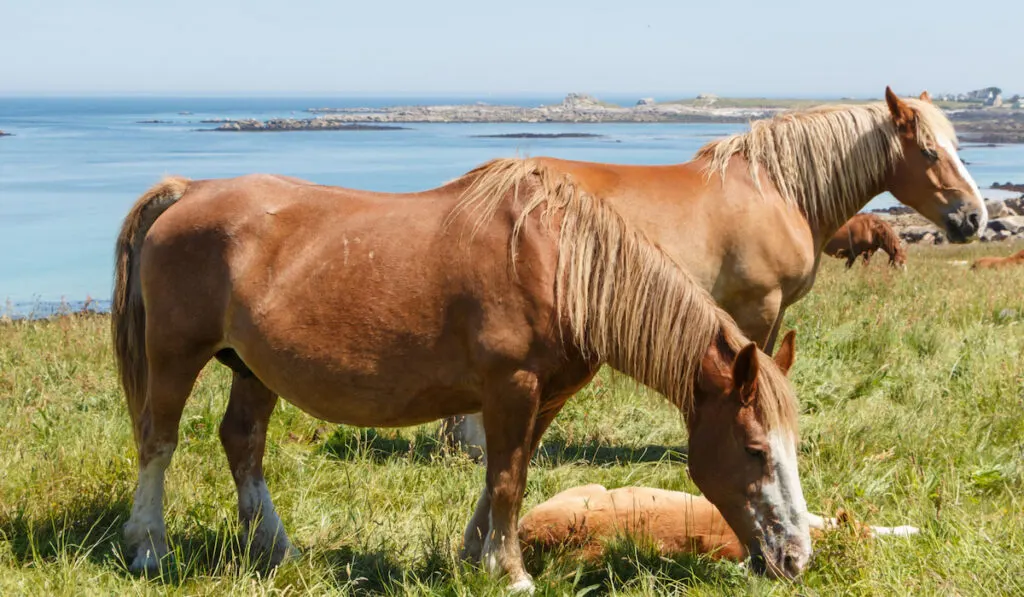
- Place of Origin: France
- Weight: 1,900-2,100 pounds
- Height: 15.1-16 hands
- Color: Chestnut, brown, and blue roan tail
- Temperament: Friendly, easy to train
- Lifespan: 25 years
The Trait Breton horse breed is from northwest France, a province called Brittany. The exact origin of this breed is unknown.
Some individuals believe that it was developed from Steppe horses used by Celtic warriors.
Others think it was created by crossbreeding several European equine and oriental breeds. The Breton horse, through the years, was crossbred with Ardennes, Percheron, and Boulonnais horses.
These horses are typically chestnut, but other colors like red are also registered. You may also find some with sand-colored mane and tails.
Some defining characteristics include muscular chests, long and sloping shoulders, broad but short backs, and well-developed hooves. Their necks are short, and their noses are straight.
Breton horses can be between 15-16 hands tall and weigh 1,800-2,400 pounds on average.
You’ll also love their friendly and calm temperament. They are also adaptable, lively, and easygoing.
The breed is versatile: Apart from being used for farm work, these horses are also used as carriage horses, pleasure riding horses, and more.
Their diet consists of feed concentrates and forage. Dietary demands increase for horses involved in heavy work.
Final Thoughts
These are some of the biggest horse breeds you’ll likely encounter. Most of them are muscular and are used on the farm, thanks to their strength. Today, these horses are used for competitions, pleasure riding, and pulling carriages, among other activities.
Resources
- https://afs.okstate.edu/breeds/horses/americancreamdraft/
- http://www.theequinest.com/breeds/australian-draught/
- https://www.globetrotting.com.au/horse-breed-australian-draught-horse/
- https://www.fei.org/stories/lifestyle/health-fitness/breed-profile-belgian-draft-horse
- https://www.petguide.com/breeds/horse/boulonnais-horse/
- http://www.theequinest.com/breeds/burmese-pony/
- https://www.ehorses.com/magazine/horse-breed/comtois/
- http://www.theequinest.com/breeds/dutch-draft/
- http://afs.okstate.edu/breeds/horses/
- https://horseracingsense.com/percheron-draft-horses/
- https://www.animalife.co.uk/horse-breeds/shire-horse/
- https://www.petguide.com/breeds/horse/breton-horse/

